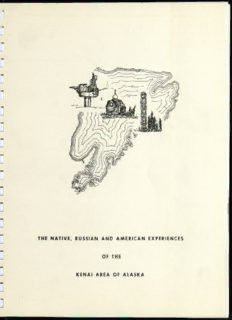
of the the native, russian and american experiences kenai area of alaska PDF
Preview of the the native, russian and american experiences kenai area of alaska
J J J J J ] ] ] ] ] ] ] THE NATIVE, RUSSIAN AND AMERICAN EXPERIENCES ] OF THE ] KENAI AREA OF ALASKA ] ] [ I' [ r I' ]1 ]1 JJ ]J ]1 THE NATIVE, RUSSIAN AND AMERICAN EXPERIENCES OF THE ]J KENAI AREA OF ALASKA Prepared for the Conference on Kenai Area History ] Sponsored by the National Endowment for the Humanities ]1 Alaska Humanities Forum JI Mayor's Advisory Committee on History and Tradition Kenai, Alaska ]1 Peggy Gill Thompson Project Director James C. Hornaday ]] Editor ] Kenai Central High School November 7-8, 1974 } ]' Jl ,JI J] JI ]1 II ~ J I -' CONTENTS Page .............. James C. Hornaday v Introducti on . . . J Native Experience Overview . Alan Boraas 5 Prehistory of the Southern Kenai Peninsula ..... Wi11iam B. Workman 11 I Prehistory of the Northern Kenai Peninsula ... Douglas Reger 27 J The Tanaina Language of Cook James Kari 35 In1et. . . Sister Victoria 45 j Russian Experience Mary Willets 83 American Experience. J 123 Authors and Consultants. 125 Acknowledgment Page. 127 Conference Schedule. J J ] J ] ] ] ] iii [ [ [ [ [ J ] Introduction ] The concept of a history conference on the Kenai Area of Alaska has been aborning several years. An essential catalyst was a visit from Gary Holthaus, Director of the Alaska Humanities Forum, to determine interest J in programs from the National Endo\~ent for the Humanities. A grant ap- plication was submitted by the Kenai Mayor s Advisory Committee on History I ] and Tradition, and approved by the Alaska Humanities Forum Board. Similarities between the format of this conference and the Conference ] of Alaska History held in 1967 are obvious and intentional. However, we have added an'addtttonal dimension: concentratton on one geographic area of Alaska to obtain further insight'into land as a bridae to community. Realizing there will be some overlappinq, we have an opportunity to observe a section of Alaska from the viewpoint of the Native, 'Russian and American Exper'i ences .' Under the able dfrecti on of Project Director Pegoy 'Gi11 Thompson, the experience chai~men ~repared the articles 'herein and the conf~rence seMinars. Alan Boraas ,' Kenai, Peninsula Conim'unityCollege, asked Dr. \~il1iam vJorkman, Alaska· Methodfst University, Douglas' Reger, Regional Archaeoloqist for the U. S.' Forest Service, ana Dr; .Jemes Kari, Alaska Native Language Cehter, to assist 'i~the p~es~ntation of the Native Experience. There a~e indicatio~s of human occupati on ot'f.he Kenai at the time of Abram s ca11ing. The I ,'Kenaitzie were 'one of the few groups of Athabascan Indians to reach the sea- coast, a"nd'there were continuing contacts with other-Native peoples . . Sister Victoria, St. Herman's Pastoral School, is in charge of the v Russian Experience, assisted by Ynez Haase, consultant. Dedicated Russian Priests, daring fur traders, conflicts with personnel of the Russian-Ameri- can Company--all played roles in the Russian Period. Alexander Baranof's capture of Konovolof in Kenai and Baranof's selection of a Kenaizie Prin- cess for a wife illustrate the importance of the Russian presence. The es- tablishment of the Russian Orthodox Church has proven to be an important and lasting influence. The American Period, as brought out by Mary Willets, Chairman of the Mayor's Advisory Committee of History and Tradition, exemplifies the various stages of development under the American Flag. Fishing, trapping, mining, agriculture, military expenditures, homesteading, oil and gas--all have Na- tional and International implications. Dr. Morgan Sherwood, Alaska-horn historian, University of California, Davis will give the conference keynote address. Dr. Sherwood and Dr. Claus Naske, History Professor, University of Alaska, are serving as consultants to the American Experience. As the United States approaches the Bi-Centennial celebration, consid- eration of Alaska's past provides a unique tangent to the traditional histor- ical approach. When the American Colonists were learning of the Declaration of Independence, Captain James Cook of England was cruising the inlet, then known as Kenai Bay (now Cook Inlet) in search of the Northwest Passage. During the Revolutionary War and the controversies over the preparation and ratification of.the United States Constitution, the Russians were estahlishing redoubts in the Kenai Area. Whereas, Manifest Destiny beckoned Americans from the East to the West in the "Iower 48,11 much of the history of Alaska involves movement from West to East. The respective experiences have blended into the present, as indicated vi by the transfer of Wildwood Air Force Station to the Kenai Native Asso- ciation, the first land transfer under the Alaska Native Lands Claims Act. Orthodox Church officials participated in the ceremony. Thus, If/e have a local history, but a history closely related to Territorial, State, National and· International development. In the words of Frederick Jackson Turner: liThehumblest locality, has in it the cos- sibility of revealing in its history, rightly told, wide reachin9 his- 1 torical events." Hopefully, this book and the conference for which it was prepared, will assist in further underctanding Alaska, the oldest and newest fron- tier on the North American Continent. Alaska furnished the land bridge ] for the earliest migrations as well as the romantic "Last Frontier" of 2 the United States. The Native, Russian and American Experiences of the ] Kenai Area of Alaska add necessary perspective as we approach the Bi- Centennial and attempt to further "... life, liberty, and the pursuit ] of happiness." ] James C. Hornaday, Editor ] Kenai, Alaska 1974 ] 1 Ouated from Ray Allen Billington, Frederick Jackson Turner (New ] York, Oxford University Press: 1973), p. 174. 2 See Robert A. Frederick, lionImagination and New Paths: Our ] Multi-Frontier in the Far North," in Frontier Alaska: Historical Inter retation and 0 ortunit , Proceedinqs of the Conference on Alaskan History Anchorage, AMU Press: 1968, p. 60, et. seq. ] ] 1 vii
Description: